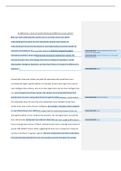Do differences in brain size predict behavioural differences across species?
Brain size varies widely between species, but it is currently unclear why. Better
understanding of the reasons for such interspecies variation may improve our
understanding of human brain development, potentially leading to practical benefits for
education and healthcare. This essay will examine the theories proposed to explain Commented [A1]: These are valid points, but they are not
relevant to the essay question.
interspecies variation in brain size, particularly focusing on residual brain volume, the Commented [A2]: These don’t explain brain size, they explain
behavioural variations.
principle of proper mass, the foraging and technical intelligence hypotheses, and the
Machiavellian intelligence hypothesis, and how these theories correspond to differences in
behaviour. Commented [A3]: Good.
A broad look at the topic of brain size yields the observation that overall brain size is
correlated with higher cognitive abilities. For example, humans have larger brains and are
more intelligent than monkeys, who in turn have larger brains and are more intelligent than
rats. Even amongst just primates, Deaner, Isler, Burkart, & van Schaik (2007) found that
absolute brain size was a strong determinant of cognitive ability. However, a closer look at Commented [A4]: Good use of evidence.
this relationship raises the issue that some substantially more intelligent animals have
smaller brains than animals of lesser intelligence; for example, a macaque's brain compared
to cow's brain (Purves et al., 2007). This implies that the relationship between brain size Commented [A5]: Good.
and cognitive ability is not as simple as first perceived. The next logical step is to study the
brain allometrically, noting brain size relative to body size. Mammals weighing 60 kilograms Commented [A6]: Good.
have an average brain volume of 200cm³, whereas humans have an average brain volume of
around 1200-1400cm³ (Harari, 2014), suggesting that brain size in comparison to body size
could be a vital factor in cognitive capacity. The term residual brain size refers to deviations
from allometrically predicted brain size. One would assume that the higher the residual
, brain size, the more intelligent the animal, and therefore the more complex the behaviour
of the species. Increasing complexity of the brain is known as encephalization, and residual Commented [A7]: Good.
brain size can also be displayed as a ratio called the encephalization quotient (EQ). The Commented [A8]: Good operationalisation of residual brain size.
highest EQ of any animal is that of humans, reaching an unparagoned 7.8 (Roth & Dicke,
2005). The next highest is the bottlenose dolphin (5.3), and amongst the lowest is the rat
(0.4). These results are to be expected given the behavioural complexity of each organism;
humans and dolphins are known for their intellectual prowess, whereas rats are not. Given
that intelligence and cognitive ability equate to behavioural complexity, we can infer from
these EQs that residual brain size is a key predictor of advanced behaviour across species. Commented [A9]: Nice link to the essay question.
Despite the clear link between residual brain size and intelligence, it is important to study
interspecies variation in the sizes of sub-regions in the brain. A concept known as the
principle of proper mass (POPM) was raised by Jerison (1974). To quote Jerison exactly, 'the Commented [A10]: Good.
mass of neural tissue controlling a particular function is appropriate to the amount of
information processing involved in performing the function' (Jerison, 1974, p. 8). In other
words, it entails the idea that brain regions increase proportionately in size dependent on
the capacity for certain behaviours. For example, the relative volume of the region of the Commented [A11]: Avoid quotes where possible; it’s fine to
describe in your own words, as you have done so nicely here, and
this renders the quote repetitive and redundant.
brain representing the forelimb is greater in racoons than in dogs, as racoons are known for
the highly developed manipulative capabilities of their paws (Sakai, 2011). Further examples
are the large superior colliculus (which plays a large role in visual perception) and small
inferior colliculus (which plays a large role in auditory perception) in the tarsier, an animal
known for being heavily dependent on its visual system, and the large inferior colliculus and
small superior colliculus in bats and dolphins, animals known for relying on sound to
navigate their environment (Purves et al., 2007). Additionally, the volume of hippocampi in Commented [A12]: Good evidence.




